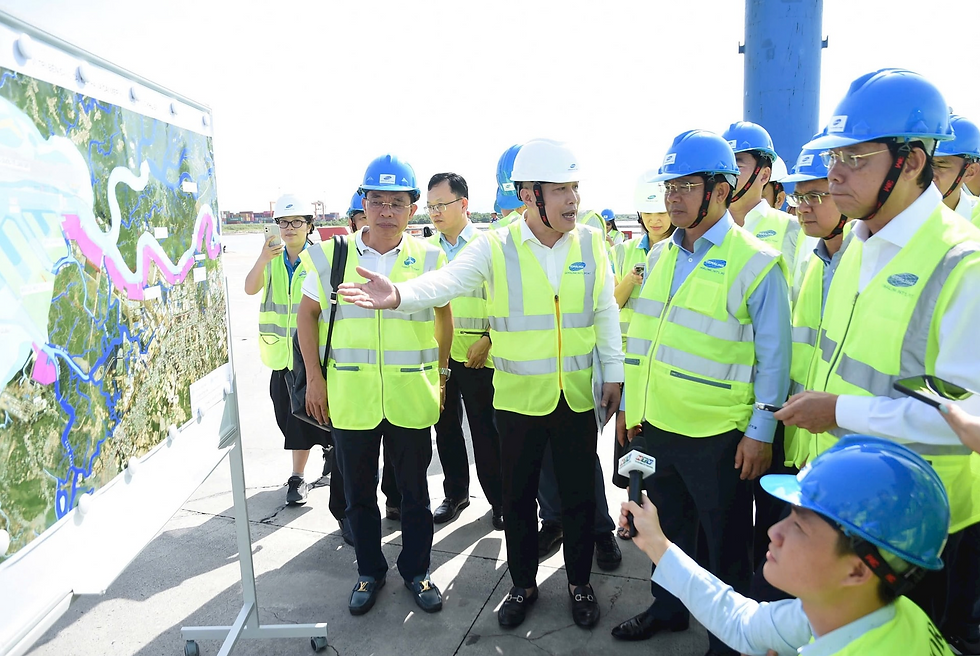Ho Chi Minh City aims to develop a smart logistics hub
- duyenthu.vietdata
- Oct 8
- 4 min read
Developing an integrated and smart logistics hub is among the key priorities outlined in the draft political report of the 1st Congress of the Ho Chi Minh City Party Committee (2025–2030 term). The initiative aims to transform Ho Chi Minh City into a financial–industrial–port megacity.
Leveraging port advantages
The draft report emphasizes that the merger of Ho Chi Minh City with Binh Duong and Ba Ria–Vung Tau marks an unprecedented milestone in Vietnam’s urban development. The integration of these three dynamic economic poles is expected to create a single financial–industrial–port supercity.

This represents a comprehensive reconfiguration of regional development space, uniting three of Vietnam’s most dynamic growth centers under a new vision — positioning the city as an international metropolis of Southeast Asia and among the top 100 most livable cities in the world.
Under the concept of “one center, three zones, one special area,” the new urban region will optimize the comparative advantages of each sub-region, forming a multi-polar mega-city built around four economic corridors and five strategic pillars:
industrial and logistics center,
international financial hub,
tourism and cultural industries,
education–health–science–technology hub,
and digital economy.
Among these, the smart logistics hub is considered a cornerstone for regional and national economic growth.
However, the draft report also notes challenges — Ba Ria–Vung Tau, despite its deep-water ports and coastal tourism potential, still faces weak regional linkages and underdeveloped supporting industries. The Cai Mep – Thi Vai Port has strong international competitiveness but lacks an integrated logistics ecosystem. Infrastructure development, especially inter-regional transport and digital logistics, remains fragmented and below strategic expectations.

In a recent development, Vietnam’s Ministry of Construction issued a written response to the Ho Chi Minh City National Assembly delegation, addressing petitions from city voters following the 9th session of the 15th National Assembly regarding the Cai Mep–Thi Vai port cluster projects.
According to the petitions, voters welcomed the Government’s policy to merge Binh Duong and Ba Ria–Vung Tau into Ho Chi Minh City, describing it as a strategic step to harness regional synergies and strengthen the city’s role as the country’s economic, financial, and technological center.
To further capitalize on Ba Ria–Vung Tau’s advantages in seaport operations and coastal tourism, voters proposed that the Government accelerate investment to develop the Cai Mep–Thi Vai port cluster into an international transshipment hub. They also called for construction of the Can Gio–Vung Tau bridge and a high-speed railwayconnecting Ho Chi Minh City, Ba Ria, and Binh Duong, which would enhance inter-regional logistics and support export–import activities.
Responding to the proposal, the Ministry of Construction confirmed that the Cai Mep terminal area — including Cai Mep Ha and Cai Mep Ha downstream — is designated in the national master plan as an international gateway and transshipment port. The complex can accommodate container ships from 6,000 to 24,000 TEU, as well as liquid and bulk vessels up to 150,000 DWT, with potential for larger vessels subject to navigational conditions.
The Ministry expressed support for early investment and commissioning of the Cai Mep Ha and Cai Mep Ha downstream terminals, in accordance with the approved seaport master plan. It also noted that the Ministry of Financeand Ho Chi Minh City authorities are currently appraising the investment proposal before submission for final approval. The Ministry of Construction has also provided its appraisal feedback.
Focus on developing a digital mega-port and integrated logistics system
The draft Political Report of the 1st Ho Chi Minh City Party Congress (2025–2030 term) identifies the development of next-generation free trade zones, smart logistics centers, international transshipment ports, and air cargo hubsas key strategic directions for 2025–2030. The plan also calls for upgrading and restructuring satellite ports, river ports along the Saigon River, and inland container depots (ICDs) to form an interconnected regional logistics network.

The Gemalink Terminal, part of the Cai Mep–Thi Vai complex and one of only 19 ports worldwide capable of handling 250,000 DWT container ships, will be extended from 510 meters to 900 meters, allowing two mega vessels to berth simultaneously. It will be linked with Cai Mep Ha, forming a 3.5-kilometer continuous quay by 2030. Including adjacent terminals such as CMIT, the total quay length could reach 11 km, and up to 22 km when fully developed — surpassing even the Port of Singapore in linear capacity.

On September 25, the Cai Mep International Terminal (CMIT) achieved a milestone by welcoming the M/V JADE, inaugurating the upgraded ZIM Mediterranean Premium (ZMPlus) service — the first direct and exclusive shipping route between Vietnam and the Mediterranean region. CMIT, strategically located near Ho Chi Minh City, is one of Vietnam’s most modern and efficient container terminals, offering direct access to key markets across Asia, Europe, and the Americas.
Together with ZMPlus and seven other weekly services, CMIT now provides global connections covering major markets in the U.S., Europe–Mediterranean, the Middle East, and Asia.
Over the past two years, CMIT has become ZIM’s Southeast Asia transshipment hub, contributing to the Government’s goal of establishing Cai Mep as a regional international gateway.
According to Bernadette Chan, General Director of CMIT,
“CMIT has always been a pioneer in adopting advanced port management and operational technologies. With increasing trade volumes, we are accelerating digital transformation and applying continuous improvement tools such as LEAN and Kaizen to enhance productivity, safety, and sustainability.We are also strengthening cooperation with nearby ports such as Hung Thai and TCTT to optimize vessel and barge handling capacity, thereby improving service quality for our customers.”
The transformation of the Cai Mep–Ho Chi Minh City port cluster into a smart, efficient, and sustainable logistics hub is expected to bolster Vietnam’s position as a key maritime gateway for Southeast Asia, enhancing global connectivity and trade competitiveness.
According to Khoa học Phổ thông
Nguồn: https://khoahocphothong.vn/tp-hcm-huong-den-phat-trien-trung-tam-logistics-thong-minh-261530.html



Comments